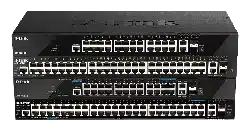Loading ...
Loading ...
Loading ...

DGS-1520 Series Gigabit Ethernet Smart Managed Switch Web UI Reference Guide
101
• Backup Master - The Backup Master is the backup to the Primary Master, and will take over the functions of
the Primary Master if the Primary Master fails or is removed from the Stack. It also monitors the status of
neighboring Switches in the stack, will perform commands assigned to it by the Primary Master and will monitor
the running status of the Primary Master. The Backup Master can be set by the user by assigning this Switch
the second highest priority (a lower number denotes a higher priority) before physically assembling the stack, or
it can be determined automatically by the stack through an election process. This determines the second lowest
MAC address and then will assign that Switch as the Backup Master if all priorities are the same. The Backup
master is physically displayed by the seven segment LED to the far right on the front panel of the Switch where
the LED will flash between its given Box ID and 'h'.
• Slave - Slave Switches constitute the rest of the Switch stack and although not Primary or Backup Masters,
they can be placed into these roles when these other two roles fail or are removed from the stack. Slave
Switches perform operations requested by the master, monitor the status of the stack topology, and adhere to
the Backup Master's commands once it becomes Primary Master. Slave Switches will do a self-check to
determine if they are to become the Backup Master if the Backup Master is promoted to the Primary Master, or
if the Backup Master fails or is removed from the Switch stack. If both Primary and Backup masters fail, or are
removed from the Switch stack, the Switch will determine if it is to become the Primary Master. These roles will
be determined by priority and if this is the same, by the lowest MAC address.
Once Switches have been assembled in the topology desired by the user and powered on, the stack will undergo
three processes until it reaches a functioning state.
• Initialization State - This is the first state of the stack, where the runtime codes are set and initialized and the
system conducts a peripheral diagnosis to determine each individual Switch is functioning properly.
• Master Election State - Once the runtime codes are loaded and initialized, the stack will undergo the Master
Election State where it will discover the type of topology used, elect a Primary Master and then a Backup
Master.
• Synchronization State - Once the Primary Master and the Backup Master have been established, the Primary
Master will assign Stacking Unit IDs to Switches in the stack, synchronize configurations for all Switches and
then transmit commands to the rest of the Switches based on the configuration of the Primary Master.
Once these steps have been completed, the Switch stack will enter a normal operating mode.
Stack Switch Swapping
The stacking feature of the Switch supports hot swapping of Switches in and out of the running stack. Users may
remove or add Switches to the stack without powering down or largely affecting the transfer of data between Switches
in the stack, as long as some basic rules are adhered to.
When Switches are 'hot inserted' into the running stack, the new Switch may take on the Primary Master, Backup
Master or Slave role, depending on configuration set on the newly added Switch, such as priority or MAC address.
Yet, if adding two stacks together that have both previously undergone the election process, and therefore both have
a Primary Master and a Backup master, a new Primary Master will be elected from one of the already existing Primary
Masters, based on priority or MAC address. This Primary Master will take over all of the Primary Master's roles for all
new Switches that were hot inserted. This process is done using discovery packets that circulate through the Switch
stack every 1.5 seconds until the discovery process has been completed.
The 'hot remove' action means removing a device from the stack while the stack is still running. The hot removal is
detected by the stack when it fails to receive heartbeat packets during its specified interval from a device, or when one
of the stacking ports links is down. Once the device has been removed, the remaining Switches will update their
stacking topology database to reflect the change. Any one of the three roles, Primary Master, Backup Master, or
Slave, may be removed from the stack, yet a different process occurs for each specific device removal.
If a Slave device has been removed, the Primary Master will inform other Switches of the hot remove of this device
through the use of unit leave messages. Switches in the stack will clear the configuration of the unit removed, and
dynamically learned databases, such as ARP, will also be cleared.
If the Backup Master has been hot removed, a new Backup Master will be chosen through the election process
previously described. Switches in the stack will clear the configuration of the unit removed, and dynamically learned
Loading ...
Loading ...
Loading ...
